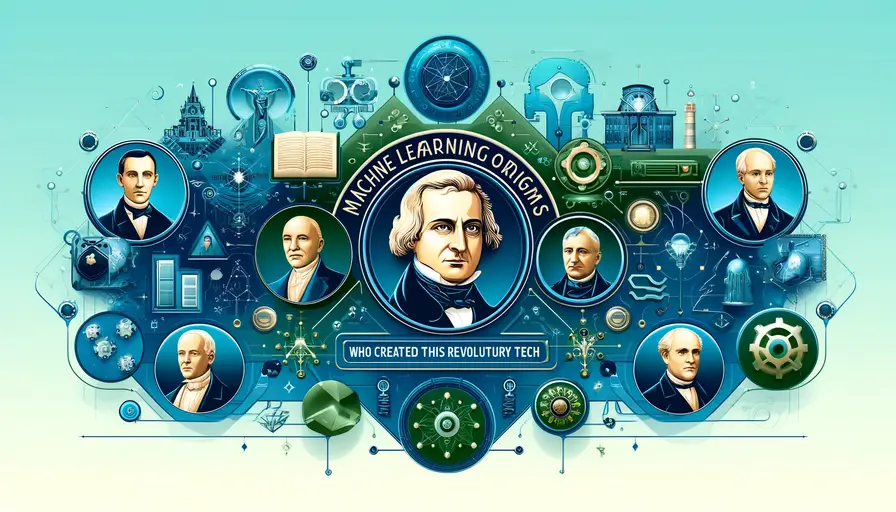
The Origins of Machine Learning

Machine learning has evolved significantly since its inception, becoming a cornerstone of modern technology and data analysis. This document explores the origins, evolution, and impact of machine learning on various fields.
The Birth of Machine Learning
The birth of machine learning can be traced back to the mid-20th century, when computer scientists and mathematicians began exploring the idea of creating machines that could learn from data. In 1959, Arthur Samuel, a pioneer in the field, defined machine learning as a "field of study that gives computers the ability to learn without being explicitly programmed." This foundational concept laid the groundwork for the development of algorithms that could improve their performance over time by learning from data.
From Rule-Based Systems to Statistical Approaches
From rule-based systems to statistical approaches, machine learning has undergone significant transformation. Early AI systems relied heavily on rule-based programming, where explicit instructions were provided for every possible scenario. While effective in controlled environments, these systems lacked the flexibility to handle real-world variability. The shift to statistical approaches allowed for the development of models that could learn patterns from data, making them more adaptable and robust. Techniques such as linear regression and decision trees became fundamental tools in this new paradigm.
Evolution and Advancements
Evolution and advancements in machine learning have been driven by increases in computational power, the availability of large datasets, and innovations in algorithm design. The advent of the internet and the proliferation of digital data sources provided a rich environment for machine learning applications. Techniques like support vector machines, neural networks, and ensemble methods emerged, pushing the boundaries of what machine learning could achieve. These advancements enabled more accurate predictions, improved decision-making processes, and the ability to handle complex, high-dimensional data.
The Purpose of Machine Learning
The purpose of machine learning is to create systems that can automatically learn and improve from experience without being explicitly programmed. This goal encompasses a wide range of applications, from predicting future trends and identifying patterns in data to making real-time decisions and automating repetitive tasks. Machine learning aims to enhance the efficiency, accuracy, and scalability of computational tasks, making it a valuable tool in many industries.
Benefits of Machine Learning
Benefits of machine learning include its ability to process and analyze large volumes of data quickly, uncover hidden patterns, and make accurate predictions. These capabilities lead to improved decision-making, increased operational efficiency, and the ability to tackle complex problems that are beyond human capacity. Machine learning also enables the development of personalized and adaptive systems that can respond to changing conditions and user needs.
A Versatile Tool for Various Purposes
A versatile tool for various purposes, machine learning is applied across multiple domains to solve a wide range of problems.
Image and Speech Recognition
Image and speech recognition are prominent applications of machine learning. Convolutional neural networks (CNNs) excel at identifying objects and patterns in images, while recurrent neural networks (RNNs) and transformers are used for speech recognition and natural language processing. These technologies power applications like facial recognition, voice-activated assistants, and automated transcription services.
Natural Language Processing
Natural language processing (NLP) involves the use of machine learning to understand and generate human language. NLP models can perform tasks such as language translation, sentiment analysis, and text summarization. These capabilities are crucial for applications like chatbots, customer service automation, and content recommendation systems.
Fraud Detection
Fraud detection leverages machine learning to identify unusual patterns and behaviors that may indicate fraudulent activity. By analyzing transaction data, machine learning models can detect anomalies in real-time, helping financial institutions and businesses prevent fraud and reduce losses.
Recommendation Systems
Recommendation systems use machine learning to suggest products, services, or content to users based on their preferences and behavior. These systems enhance user experience by providing personalized recommendations, driving engagement, and increasing sales for businesses.
The Origins of Machine Learning
The origins of machine learning lie in the desire to create systems that can learn and improve automatically. Early experiments with algorithms that could adapt to data laid the foundation for modern machine learning. Researchers aimed to develop techniques that could handle the variability and complexity of real-world data, moving beyond the limitations of rule-based systems.
Efficiency Improvement
Efficiency improvement is a key benefit of machine learning. Automated processes powered by machine learning can handle large volumes of data faster and more accurately than manual methods. This leads to significant time savings and allows organizations to focus on higher-level tasks.
Accurate Predictions
Accurate predictions are made possible by machine learning algorithms that learn from historical data. These predictions can be used in various fields, such as finance for stock market forecasting, healthcare for disease prediction, and marketing for customer behavior analysis.
Insights from Complex Datasets
Insights from complex datasets are derived using machine learning techniques that can uncover patterns and relationships not easily detectable by traditional methods. These insights drive informed decision-making and strategic planning.
Optimizing Processes
Optimizing processes involves using machine learning to enhance efficiency and productivity. For example, in manufacturing, machine learning can predict equipment failures and schedule maintenance, reducing downtime and costs.
Reducing Costs
Reducing costs is a significant advantage of machine learning. By automating tasks and improving efficiency, machine learning helps organizations save on labor and operational expenses.
Improving Customer Experience
Improving customer experience is achieved through personalized recommendations, faster response times, and better service. Machine learning enables businesses to understand customer preferences and deliver tailored experiences.
The Rise of Machine Learning Algorithms
The rise of machine learning algorithms has been fueled by advancements in computational power, data availability, and research in algorithm development.
The Era of Big Data and Deep Learning
The era of big data and deep learning has transformed machine learning. With vast amounts of data available, deep learning algorithms, particularly neural networks, have become highly effective at solving complex problems. This era has led to breakthroughs in areas like computer vision, speech recognition, and natural language processing.
Types of Machine Learning Algorithms
Types of machine learning algorithms include supervised learning, unsupervised learning, and reinforcement learning. Supervised learning uses labeled data to train models, unsupervised learning finds patterns in unlabeled data, and reinforcement learning trains models through trial and error.
The Future of Machine Learning
The future of machine learning looks promising, with continuous advancements in algorithms, data availability, and computing power. Emerging fields like quantum computing and artificial general intelligence (AGI) hold the potential to further revolutionize machine learning.
Advancements in Data Availability and Processing Power
Advancements in data availability and processing power have significantly enhanced the capabilities of machine learning models. With more data and faster processors, models can be trained on larger datasets and more complex tasks, leading to better performance and new applications.
Applications in Various Industries
Applications in various industries demonstrate the versatility of machine learning. In healthcare, it aids in diagnostics and personalized treatment plans. In finance, it enhances fraud detection and algorithmic trading. In retail, it powers recommendation systems and inventory management.
The origins and evolution of machine learning have paved the way for its widespread application across various fields. Its ability to learn from data, make accurate predictions, and optimize processes continues to transform industries and improve lives. The future holds exciting possibilities for further advancements and innovations in machine learning.
If you want to read more articles similar to The Origins of Machine Learning, you can visit the Education category.



You Must Read